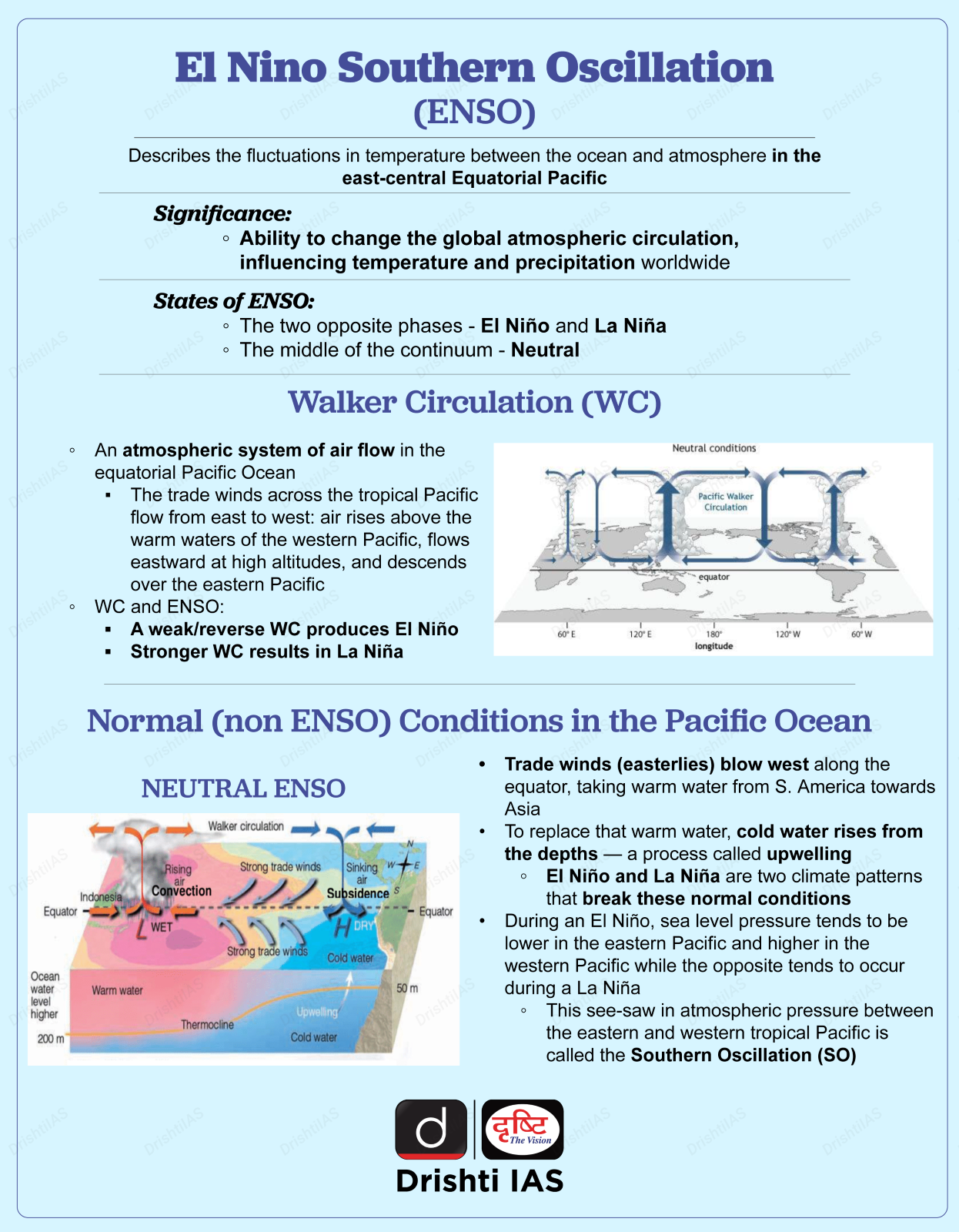Geography
El Nino
- 08 Apr 2023
- 7 min read
For Prelims: EL Nino, ENSO, Southwest Monsoon Season, Heatwaves, Droughts, WMO.
For Mains: El Nino and its Impact.
Why in News?
Many climate models have forecasted an El Nino in May 2023.
- A record three-year La Nina event ended in March 2023 and currently, the equatorial Pacific Ocean is at normal temperatures, known as the neutral phase.
What is El Nino?
- El Nino was first recognized by Peruvian fishermen off the coast of Peru as the appearance of unusually warm water.
- The Spanish immigrants called it El Nino, meaning “the little boy” in Spanish.
- The El Nino is the warmer-than-normal phase of the El Nino Southern Oscillation (ENSO) phenomenon, during which there are generally warmer temperatures and less rainfall than normal in many regions of the world, including India.
- During an El Nino event, the Sea Surface Temperatures (SST) in the equatorial Pacific Ocean off the northern coast of South America became at least 0.5 degrees Celsius warmer than the long-term average.
- In the case of a strong El Nino event as occurred in 2015-2016, anomalies can reach as high as 3°C, which is a record.
- The El Nino event is not a regular cycle, they are not predictable and occur irregularly at two- to seven-year intervals.
- Climatologists determined that El Nino occurs simultaneously with the Southern Oscillation.
- The Southern Oscillation is a change in air pressure over the tropical Pacific Ocean.
- Climatologists determined that El Nino occurs simultaneously with the Southern Oscillation.
What do the Climate Models Say About Upcoming El Nino?
- Impact on India:
- Weak Monsoon for India: The development of an El Nino in May or June 2023 may cause weakening of the southwest monsoon season, which brings around 70% of the total rainfall India receives and on which most of its farmers still depend.
- However, sub-seasonal factors such as the Madden-Julian Oscillation (MJO) and monsoon low-pressure systems can temporarily enhance rainfall in some parts as witnessed in the year 2015.
- Hot Temperatures: It may also cause heatwaves and droughts in India and other regions around the world such as South Africa, Australia, Indonesia and the Pacific Islands.
- Weak Monsoon for India: The development of an El Nino in May or June 2023 may cause weakening of the southwest monsoon season, which brings around 70% of the total rainfall India receives and on which most of its farmers still depend.
- Heavier Rainfall in the West: It brings heavy rainfall and flooding to other regions such as California in the United States and could cause bleaching and death of coral reefs.
- Rising Global Average Temp: The El Nino in 2023 and going into 2024 may push the global average temperature towards 1.5°C warmer than the preindustrial average.
- The warming of the oceans is also one of the major impacts of an El Nino event.
- This is when ocean heat content is already at a record high, according to the World Meteorological Organization (WMO).
- The warming of the oceans is also one of the major impacts of an El Nino event.
- Previous Such Occurrences – Impacts:
- In the 2015-2016, there were widespread heatwaves in India that killed around 2,500 people in each of the years.
- Coral reefs around the world also suffered from bleaching and the sea level rose by 7 millimetres due to thermal expansion.
- The El Nino, along with global warming, had made 2016 the warmest year on record.
- El Nino events of 1982-83 and 1997-98 were the most intense of the 20th century.
- During the 1982-83 event, sea surface temperatures in the eastern tropical Pacific were 9-18°C above normal.
- In the 2015-2016, there were widespread heatwaves in India that killed around 2,500 people in each of the years.
What is MJO?
- The MJO is made up of two parts: an enhanced rainfall phase and a suppressed rainfall phase.
- During the enhanced phase, surface winds converge, causing air to rise and create more rainfall. In the suppressed phase, winds converge at the top of the atmosphere, causing air to sink and leading to less rainfall.
- This dipole structure moves west to east in the Tropics, creating more cloudiness and rainfall in the enhanced phase, and more sunshine and dryness in the suppressed phase.
How does ENSO Affect India?
- The influence of ENSO on India's climate is most pronounced during the monsoon season. During an El Niño event, India experiences below-average rainfall.
- The El Niño also leads to a rise in temperatures, exacerbating heat waves and causing heat-related health issues.
- On the other hand, during a La Niña event, India experiences above-average rainfall.
- This can lead to flooding and landslides, damaging crops and infrastructure. However, La Niña also brings cooler temperatures, which can provide relief from heat waves.
UPSC Civil Services Examination, Previous Year Question (PYQ)
Prelims
Q. With reference to ‘Indian Ocean Dipole (IOD)’ sometimes mentioned in the news while forecasting Indian monsoon, which of the following statements is/are correct? (2017)
- IOD phenomenon is characterised by a difference in sea surface temperature between tropical Western Indian Ocean and tropical Eastern Pacific Ocean.
- An IOD phenomenon can influence an El Nino’s impact on the monsoon.
Select the correct answer using the code given below:
(a) 1 only
(b) 2 only
(c) Both 1 and 2
(d) Neither 1 nor 2
Ans: (b)
Mains
Q. Most of the unusual climatic happenings are explained as an outcome of the El-Nino effect. Do you agree? (2014)






